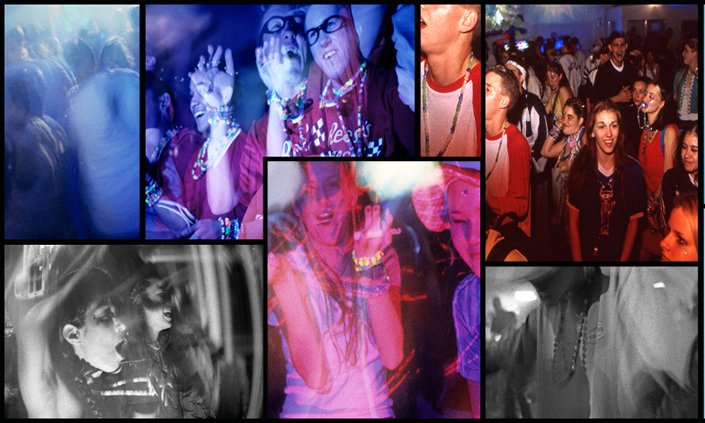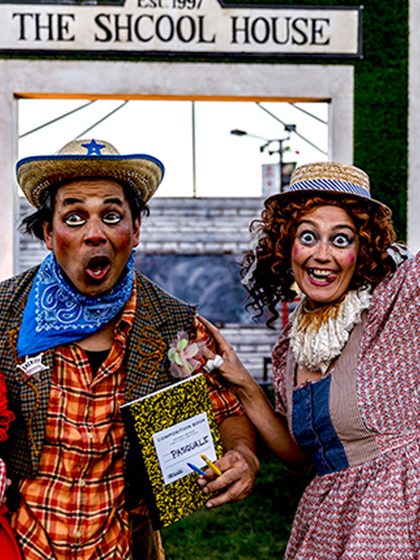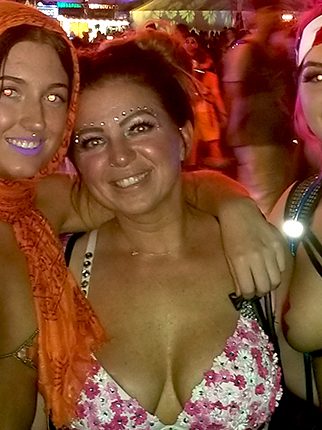Exploding Underground: 5 Seminal L.A. Parties During Dance Music’s Second Coming
When I was shooting the American rave scene in the 1990s and 2000s, I was keenly aware that I was bearing witness to not simply a new and unusual music trend, but rather a seismic shift in pop culture, one that virtually nobody in the mainstream knew about. The underground revolution known as dance music was changing the landscape of American entertainment, just as surely as jazz, rock, punk and hip-hop had before it. Once again, the most progressive and forward-thinking music and social scene had come not from the boardrooms and studios of the record labels; it had come from the street. It built itself up, one party at a time, one fan at a time. And then two fans. Then fifty. Hundreds. Thousands. It was a beat-driven trickle that eventually roared into a tsunami, sweeping all before it into a maelstrom of delicious chaos.
This was not anarchy, though it was revolutionary in its own way. It was a progression driven steadily forward by a hugely dedicated community of fans, artists, technicians and promoters who were heartfelt and passionate about what they were doing. They had to be, considering how the mainstream took nearly every opportunity it could to discredit and marginalize the rave scene. Those veterans can tell relative newbies tales about parties being broken up with police helicopters and tear gas, among other items. You can still find online some of the old “investigative” TV news pieces about the scene, which were largely devoid of little annoyances like “verifiable facts” or “reality.” For the scene to persevere and even thrive under such persecution took a remarkable commitment, one that eventually made today’s EDM world possible.
During what I call the “second wave,” I was fortunate to have placed myself right in the center of raving culture in North America. That’s what Los Angeles (and Southern California in general) was in those days; even though the music had spread all over the country and had hotbeds in many major cities, L.A. was the core, for several reasons. More major DJs were coming through L.A. on a regular basis, and many of them ended up moving here; and Southern California had so many more venue options than other cities did. While gigs in most other places were restricted to warehouse or club locations, L.A. had no such encumbrances. Thus, you could find parties on mountains, in the desert, on the beach, or wherever someone was clever enough to put a sound system, and where outsiders weren’t watching. From 100-person after-hours parties to 40,000-person massives, we truly had it all. When you add the nearly endless California sunshine, you can begin to understand why so many gravitated toward this place. There were so many events that it wasn’t unusual during the peak years to be able to party from Thursday straight through to Sunday (don’t get me started on the Monday Social!). Looking back, it’s clear that Angelinos were really spoiled.
I managed to shoot hundreds of raves around the country, and I was lucky to be present for some truly incredible and memorable moments. People sometimes ask me what the most amazing party or seminal moment was, but quite honestly, it’s just about impossible to reduce everything down to one singular event. Instead, please enjoy this collection of stellar events that, if nothing else, illustrate the wide variety of top-notch entertainment the rave scene provided.
(1) DUNE 4

This epic party was the last of the great California desert raves of the ‘90s. It was completely isolated from just about anything else on earth, which is part of the point of a great desert rave. With no light pollution, a sky-wide blanket of a billion jewel-like stars created an incredible, otherworldly nocturnal atmosphere… that is, until a huge sandstorm came blasting through the place. While most went racing for their tents (many of which offered little guarantee of protection from the elements), a dedicated cadre of dancers remained in the swirling, stinging winds while Christopher Lawrence was having his acetates grooved out by the sand that covered everything. Eventually the storm blew itself away, and as dawn crept over the horizon, the crowd was re-energized by high-octane sets from Robbie Hardkiss and Doran. It was one of the most unique and memorable experiences in my book.
(2) HOW SWEET IT IS 2001

This B3 CandE semiannual massive ended up being one of the largest and most successful parties of its kind on the SoCal rave circuit. While the promoters of the event always decorated their stages with plenty of trees and shrubbery, I recall the 2001 edition having a particularly lush collection of foliage. It was a far cry from most of the traditional candy-themed decoration of the day, and even more so in today’s EDM world. It was a great balance of music and atmosphere that is at the heart of every great party. I think they would’ve liked to put up an entire forest, though they probably would have had to empty almost every local plant nursery to do it!
(3) NOCTURNAL WONDERLAND 2000

I remember the 2000 installment of Nocturnal being a major turning point for raves in North America. It was held at the Empire Polo Fields in Indio, where Coachella and Stagecoach reside. The attendance that year was over 40,000, which I believe at the time was the record for a single-night rave in America. It was also higher than the two editions of Coachella that had preceded it in the exact same place. And bear in mind that Insomniac accomplished this with no corporate sponsorship of any kind—no major ad campaigns, no record company support, no mass media coverage, no nothing. It was done through the regular channels of rave information: flyers, party info lines, the dance music mags of the day, and the local underground press. In other words, it was a primitive form of social media, years before Facebook and Twitter. Today, this form of promotion is commonplace, but in 2000, it was pioneering.
When I saw the enormous crowd from the mainstage, I knew this was going to be a pivotal moment for the scene. The success of NW2000 meant this music (and the people who enjoyed it) could no longer be simply ignored or belittled. After this, it had to be taken seriously by the outside world; the numbers alone mandated it. From this point on, after it became clear that massives were regularly outdrawing big, mainstream arena acts like Mariah Carey and Metallica, the music media was forced to begin reevaluating this culture.
(4) INSIGHT

Insight was actually two small parties, held only a few months apart in L.A. in 1996 and ‘97. They held only a few hundred or so apiece, but size wasn’t the issue here. The atmosphere was so fantastic, thanks in no small part to the efforts of the promoter, who was only 19 or 20 at the time. He worked his ass off to create a great vibe (as did the DJs, naturally), and his efforts paid off in spades. He put loads of old-school film loop projections in there to cover the walls with pulsating, throbbing light. When you get a whole room looking like that, it’s definitely a trip and a half, to say the least. When I brought down the owner of the gallery where my first rave photo exhibition was being held, he went absolutely gaga for the party. It just goes to show that you don’t need a massive to have a great rave.
(5) THE HOLLYWOOD PALLADIUM, 3/1998

This was a gig that just about encapsulated the high point of rave music’s commercial success in North America in the late ‘90s. The lineup was an all-star one: the Crystal Method, fired up and in prime form supporting their groundbreaking Vegas album; the Propellerheads, in one of their rare U.S. appearances; Fatboy Slim at the height of his “Rockafeller Skank” period, when “Praise You” was on the charts; David Holmes, just after his Essential Mix CD was voted Mix of the Year; and BT, supporting his second album, ESCM. At the time, it felt like the music was on the verge of a major mainstream breakthrough, and package concerts in metropolitan venues like the Palladium only contributed to that anticipation. Little did we know that many more years in the wilderness were still to follow.
Michael Tullberg’s upcoming book, Dancefloor Thunderstorm: Land of the Free, Home of the Rave, will be released in the next few months. More info is available here.
Follow Michael Tullberg on Facebook | Twitter





